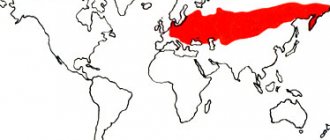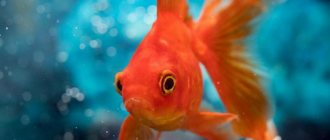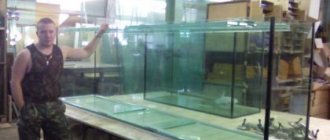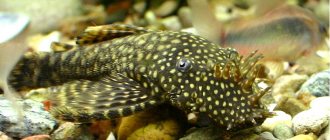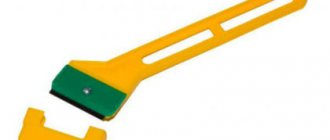Ancient predecessors of the aquarium
The first aquarists were the Chinese. For about four thousand years they have been keeping and breeding various fish (first in artificial reservoirs, later in vessels), and the selection of the famous goldfish has been going on for almost two thousand years. The massive hobby for breeding goldfish dates back to the reign of the Song Dynasty (10th-13th centuries). About two and a half thousand years ago, in another Asian country - in Japan - they began to breed carp and develop decorative breeds of these fish - koi, and the goldfish in the Land of the Rising Sun acquired a wonderful feathery shape. But in other ancient states, especially in Egypt, fish and aquatic plants, in particular lotus, were kept in special pools. The gardens of Egyptian pharaohs and nobles were famous for such pools. King Nebuchadnezzar of Assyria in the 6th century BC. e. decorated one of the seven wonders of the world with ponds and pools - the legendary Hanging Gardens of Babylon. In Ancient Rome, ponds with running water (piscina) and aquaria (cages and vessels for fish) were an indispensable part of the homes of wealthy Roman citizens. In these early aquariums, not only fish, but also invertebrate animals such as cuttlefish were on display. The water in the piscina changed frequently, and they were protected from the sun by special canopies. On the American continent, the Aztec ruler Montezuma (c. 1390-1469) was fond of contemplating fish. He kept several unique aquariums in his palace, called “devilish vessels.” The craze for live fish came to Europe from China along with porcelain in the 16th and 17th centuries. By the end of the 18th century, vases and garden basins with goldfish and aquatic plants were already common in Europe. The emergence of aquarium farming in its modern sense occurred in Europe and the USA in the mid-19th century. The first aquarium in its modern form had a volume of about 100 liters and was created in 1841 by the English scientist H. Ward. This aquarium contained cold-water fish and plants. In 1848, another Englishman, E. Lancaster, bred the first fish in an aquarium - three-spined sticklebacks. In 1849, the world's first exhibition of aquariums and terrariums was opened at London Zoo. In 1853, the German naturalist Emil Adolf Rossmessler coined the term "aquarium". In 1854, the first book on aquarium husbandry, “Aquarium, or Discovered Wonders of the Deep,” written by Edinburgh University professor P. Gosse, was published in Great Britain. In 1856 and 1857, two books by the German scientist Rossmessler were published in Germany - “The Sea in Glass” and “Freshwater Aquarium”. Following London, public aquariums were opened in other European cities - in Vienna (1860), Paris (1861), and Berlin (1869). In 1865, the first public aquariums opened in the United States - in New York and Boston. In 1869, the French naturalist Pierre Carbonnier introduced the first exotic fish into the amateur aquarium hobby - macropods, brought on the warship "Empress" from China. In 1874, he also introduced the second tropical species into the aquarium hobby - bettas. In 1904, a public aquarium opened at the Moscow Zoo. Having crossed the turn of the 20th century, the aquarium industry began to grow and develop more and more rapidly. By the end of the millennium, it represented a whole layer of human culture, permeating many related areas of creativity of people around the globe. Societies and clubs of aquarists from all countries are united into the international union Aqua-Terra-International, headquartered in The Hague (Netherlands).
The first aquariums. History of aquarium farming
The first aquariums were extremely simple - a glass container filled with water from a well. Caring for such an aquarium consisted of feeding its inhabitants and replacing dead fish with live ones caught in the nearest pond. The water was renewed only when it began to deteriorate and spread a heavy odor.
Ancient China: domestication of crucian carp
The idea of keeping fish at home belongs to the Chinese, and the first aquarium inhabitant was crucian carp, but it was not an ordinary fish. For breeding, individuals were selected with congenital defects and even developmental defects (bulging eyes, forked tail, lack of fins), as well as with unusual coloring, different from natural. The crossing of such fish led to the emergence of a new breed of red-golden color with a metallic tint.
Chinese goldfish. Picture on the wall in a Chinese temple
The first written mention of fish with red scales dates back to the Qin Dynasty (265–420 AD).
Several centuries later, this miracle fish was brought to Russia, where it received the name goldfish (Carassius auratus).
Korea and Japan: pond fish farming, koi carp
Subsequently, the fashion for colorful fish spread to other civilizations of the Far East - Korea and Japan. There, based on Chinese selection of crucian carp, fish breeding was directed in a slightly different direction. Japan and Korea are considered the creators of long-bodied goldfish breeds, such as Shubunkin, Comet, etc.
In addition, the Japanese transferred their Chinese experience with goldfish to common carp (Cyprinus carpio carpio), which we often see on our table as various dishes.
Koi carp in a pond in Nagoya city, Japan
Breeding these fish, selected based on their color, has become one of the national Japanese arts. Colored carp are called "koi" all over the world by the Japanese word.
Goldfish in Europe - an overseas curiosity
Only in the 17th century. Thanks to Dutch and Portuguese merchants, goldfish first came to Europe. They were very expensive, and died in huge numbers. The main reason for the mass death was associated with the deep-rooted opinion that these heavenly creatures feed only on “ether”, and the rest of the food is dangerous for them.
Goldfish seller. Leslie George Dunlop. XIX century
However, the most advanced naturalists argued that fish can sometimes enjoy bread, and it does not harm them at all. Gradually, people became convinced that the golden inhabitants still needed not only bread, but also various organic foods. From this moment on, the first professional aquarists and fish sellers appeared.
The first full-fledged aquarium was created only in 1841. The English scientist Nathaniel Ward conducted experiments on growing plants in glass containers and placed goldfish with a Vallisneria plant in one of them. Ward is considered the inventor of the aquarium in its modern form - a vessel with water designed to contain plants and animals.
The three-spined stickleback is one of the first inhabitants of European aquariums
Already in 1849, the first exhibition of fish and reptiles began operating at the London Zoo. After some time, pavilions began to open one after another in New York, Boston, Vienna, Paris, Berlin and Frankfurt am Main.
Russia: Zolotnitsky and the first aquariums
Goldfish arrived on the territory of modern Russia - the Grand Duchy of Moscow - much earlier than in Europe. Chronicles of the 15th century. mention small strange creatures that were brought with caravans along the Great Silk Road.
Written sources say that in the 16th century. Foreign ambassadors more than once presented Tsar Ivan the Terrible with glass balls with wonderful oriental fish.
Under Peter I, prestigious vases with overseas fish increasingly began to appear in noble houses. They were considered an indicator of success and style, but it was too early to talk about the development of aquarium hobby as a mass hobby.
The first professional aquarist in the Russian Empire was an ethnic Belarusian, a native of Brest-Litovsk, Nikolai Fedorovich Zolotnitsky . This man can be called a real ascetic naturalist, an explorer of nature, as they said at the end of the 19th century, when he began his active work in the field of aquarium farming.
The first professional Russian aquarists N. F. Zolotnitsky (left) and A. S. Meshchersky (right)
In the early 1980s. in the journal “Nature and Hunting” N. F. Zolotnitsky published a number of articles on keeping various biological objects in aquariums, including goldfish, macropods (Macropodus opercularis), in Russia they were called paradise fish, as well as some domestic fish species.
In 1885, the articles published in the magazine were published as a separate book, “The Amateur’s Aquarium,” which remains relevant today. Thus, Russia was one of the leading European countries in the field of aquarium fish farming.
The real boom in aquarium hobby began in the late 1980s, and the mentioned book served as the impetus for this. N. F. Zolotnitsky dedicated his work to his aquarium friends A. S. Meshchersky and V. S. Melnikov. For the book, the scientist was awarded the Big Gold Medal of the Russian Society of Acclimatization, as well as a gold medal in Kyiv and an honorary medal in Paris.
Macropod is the first tropical fish to settle in Russian aquariums
Aquariums of the late XIX - early XX centuries. had very good technical characteristics. Mirror systems were used for lighting; In addition, specially designed kerosene lamps served as both lighting and heaters. Forced aeration of water took place using rubber bulbs, as well as various pumps, first with a pedal, then with an electric drive.
Aquariums in Russia
The first aquarium fish came to Russia in the second half of the 17th century. Then the first vase with goldfish appeared in the Moscow “apothecary garden” of Tsar Alexei Mikhailovich, presented to him as a precious gift by the British. In the second half of the 19th century, the aquarium hobby began to flourish in Europe, the USA, and at the same time in Russia. In 1863, in Moscow, as part of the First Acclimatization Exhibition, the first exhibition of aquariums with domestic freshwater fish was held. About 20 thousand visitors visited this exhibition. In 1867, the first domestic and one of the world’s first specialized books on aquarium husbandry, “Wonders of Water in the Room,” was published in St. Petersburg. Indoor aquarium and its inhabitants” by P. A. Olkhin. In 1878, the Second Acclimatization Exhibition took place at the Moscow Zoo. It featured about 30 species of fish, including gourami and goldfish, as well as a range of aquatic invertebrates. From 1887 to 1898, 8 more exhibitions were held in Moscow, where both freshwater and marine, tropical and domestic aquarium fish and several dozen species of plants were presented. In 1899, another exhibition was held by the newly created circle of aquarists and indoor plant lovers. When the new building of the Sevastopol Marine Biological Station was built in 1896, the country's first public marine aquarium opened in its basement. In 1899, a circle of aquarists and indoor plant lovers was created in Moscow, which in 1905 was transformed into the Moscow Society of Aquarium and Houseplant Lovers. In 1902, the first domestic periodical publication on aquarium husbandry began to be published - “The Journal of the Society of Lovers of Houseplants and Aquariums” (St. Petersburg). In 1908, the Moscow Society of Aquarium and Houseplant Lovers began publishing a magazine, “Aquarium and Houseplants.” In 1911, the first issue of the “Bulletin of the Aquarium and Terrarium Lover” was published in Kyiv. The Aquarium pavilion with a permanent exhibition of fish and plants was opened at the Moscow Zoo in 1904. In 1911, the first store in Russia, “Aquarium Fish Farming” by V. Ya. Stulov, opened in Moscow. The pre-revolutionary period in Russia, which was experiencing economic growth, became the heyday of the aquarium hobby. The new government, two world wars, and the cataclysms of the first half of the 20th century could not help but reduce interest in aquarium farming and the pace of its development, although it was in the 1930s that a number of state-owned pet stores opened in the USSR, and Aquarium pavilions appeared in large zoos. In the post-war years, there was a revival of interest in aquarium husbandry, but at the same time, a gap emerged in the level of development of Soviet and Western aquarium husbandry. A new surge of interest in aquarium husbandry occurred in the USSR in the 1980s. The Moscow city club of aquarists and terrariumists named after. N.F. Zolotnitsky, where sections specializing in various aquarium fish were formed. Exhibitions with both general aquarium themes and specialized ones were often held. An increasing number of new species of fish and plants were brought to the USSR, and new periodicals dedicated to aquarium husbandry appeared. Professional aquarium fish farms, companies, permanent exhibitions, and cooperative stores appeared. In 1987, the All-Union Association of Aquarium and Terrarium Clubs was formed. The fall in living standards in the early 1990s caused significant damage to the domestic aquarium hobby: some species of animals and plants that were once brought to Russia disappeared, clubs practically ceased to operate, and the number of aquarists themselves noticeably decreased. At the same time, the opportunities for international contacts have expanded, and as the economic situation in Russia stabilizes, a new breakthrough in the development of aquarium farming is possible.
What is aquarium farming?
This is all about creating a special underwater world in a small enclosed space of an aquarium. Aquarium keeping is a very ancient art that has not lost its relevance today. There are facts in the literature that mention that the cultivation of ornamental fish was practiced in ancient Egypt, Assyria and China. At that time, aquariums were stone bowls and served as decorations for temples, monasteries, palaces and houses of wealthy citizens. Later, in the 19th century, glass vessels began to be used for these purposes, more reminiscent of modern aquariums: soil, aquatic plants, different types of fish and sea animals were placed there.
Modern aquarium farming has a lot of directions: some people breed fish, some people breed plants, like a real gardener, and some people grow corals. Real coral reefs in an aquarium, inhabited by small colored fish, look so fantastic and fascinating that it is difficult to take your eyes off this miracle! In essence, aquarium hobby is the mysticism of the underwater world. Each of its adherents is a creator. The special world of the aquarium lives and develops according to laws subject to its creator. What it will be like depends only on the capabilities and imagination of the aquarist.
Commercial aquarium keeping is an industry, an aquarium business, that allows many hobbyists to pursue their favorite hobby. This includes the breeding of fish for sale, the production of aquariums, the creation of various devices for them, the production of food, and the publication of special literature.
Amateur aquarium hobbyist does not have any benefits in mind other than the pleasure of fiddling with the aquarium and its inhabitants. And unlike scientific aquarium farming, it is not so much engaged in study and development as in the creation of underwater worlds in individual home aquariums. At the same time, amateur observations and experiments contribute to the development of science. Moreover, aquariums and oceanariums around the world have become a repository of genetic material for many endangered and rare species of fish. This makes aquarists valuable participants in the international program to save rare species.
Amateur aquarium keeping can be divided into different areas: fish breeding, aquatic plant breeding, amphibian and reptile breeding, invertebrate animal breeding. All these areas can combine in one aquarium, forming a full-fledged ecosystem, albeit a closed one. But such a plan will require extensive professional knowledge.
Passion for aquarium keeping
Many people began to get interested in aquariums from childhood, when they first filled a small aquarium with water and put a couple of goldfish in it. Year after year, gaining experience, the aquarist becomes a master of his craft. Investing effort and money in maintaining an aquarium cannot but bring joy when day after day you watch the life of the amazing underwater world that you created with your own hands! Over time, a passion for aquarium farming can become a source of income. However, those who like to make quick money will be disappointed here. Before becoming a professional, you will have to spend a lot of time, effort and money. Aquariums do not tolerate careless treatment, but if you approach the matter thoroughly and with love, the result will certainly be achieved. And what a result! When visiting museums of the underwater world and exhibitions of aquarium fish, one can only be amazed that such beauty as can be seen there was created by someone’s hands in a single creative union with nature.
Tips for a beginner aquarist
If you have no experience, it’s better to start aquarium farming small. First you have to get a taste. First of all, it is advisable to read books from the “Aquarium Science for Beginners” series, visit Internet resources, communicate with experienced aquarium owners, in a word, decide whether an aquarium can become a part of your life and whether you are ready to constantly, day after day, find time for new things hobbies.
We hope that aquarium hobby will not only bring you joy, but also benefit your home. It has been noticed that long-time adherents of the aquarium hobby are harmonious and balanced people. And this is not surprising - observing the life of aquatic inhabitants has a beneficial effect on the state of mind and generally improves the health of the body. And an aquarium harmonizes the space of the house and simply decorates any room.
History of aquarium farming
If we look at history, aquarium farming began in China during the Tang Dynasty (618-907). Already in those distant times, selection work was carried out in China on silver crucian carp with the subsequent production of its breeding species, which was called the well-known goldfish.
The first goldfish were brought to Europe at the beginning of the 17th century, and they were brought to Russia during the reign of Alexei Mikhailovich, the father of Peter the Great. Initially in Europe, goldfish were kept in the vases and basins of wealthy nobles.
At the end of the 17th century, great interest in southern aquatic plants arose in European countries; Many rich houses in England, France and Germany had extensive greenhouses and greenhouses with swimming pools. These pools were often populated with fish, which gave a certain impetus to the development of aquarium farming.
In Europe, the beginning of the rapid development of aquarium husbandry occurred in the middle of the century before last and is closely associated with the name of the German naturalist Emil Adolf Rossmesler (1806...1867). In 1857, his book “The Sea Behind Glass” was published in Germany, and the following year - “Freshwater Aquarium”.
Mistakes of beginner aquarists
Domestic aquarists
A.I. Hamburger, one of the pioneers of domestic aquarium plant growing and fish farming, was the initiator of the production of frame aquariums in Russia according to German models. He was the first to bring the Madagascar aponogeton - uvirandra - to Moscow and presented it in 1872 in the horticulture department at the Polytechnic Exhibition. He also brought the first macropods to Russia from France. K.K. Gippius is an honorary member of the Moscow Society of Aquarium and Houseplant Lovers, editor of the Aquarium and Houseplants magazine, published since 1908. He was one of the first to introduce aquarium farming and begin breeding domestic fish. As an award in the aquarium industry, there was a prize named after Gippius. On September 12, 1910, Gippius opened one of the first private permanent aquarium exhibitions in Europe in his house in Teply Lane in Moscow. The exhibition featured 114 aquariums and pools, the largest of which had a volume of three and a half tons. The aquariums contained about 100 (and later 150) species of domestic and tropical freshwater fish. Gippius also owned the most famous domestic pet store of that time, located in Moscow on Myasnitskaya Street. V. M. Desnitsky, a Moscow aquarist of the late 19th and early 20th centuries, brought many exotic fish from abroad and introduced them into the aquarium hobby. P. G. Emelianenko was a Kiev aquarist of the late 19th and early 20th centuries, one of the founders of the Kyiv Society of Aquarists, which opened in 1906. Emelianenko was one of the first domestic lovers of marine aquariums, the author of a number of brochures on aquarium husbandry, including “Fish Diseases and Methods for Their Treatment” (1907) and “Viviparous Fish, Their Maintenance and Breeding” (1908). N. Yu. Zograf, a Russian scientist and aquarist of the late 19th and early 20th centuries, headed the Ichthyology Department of the Russian Society for the Acclimatization of Animals and Plants, actively contributed to the development of Russian aquarium husbandry and the holding of the country's first aquarium exhibitions. N. F. Zolotnitsky (1851-1920) - the most prominent domestic aquarist of the late 19th - early 20th centuries. His most famous published work is the book “The Amateur’s Aquarium.” This monograph was published in 1885 and was expanded and reprinted four times. In addition, the book has been translated into several foreign languages. In 1993, the latest Russian edition of this book was published again thanks to the efforts of the Terra publishing house. The book gained worldwide fame, and its author was awarded several top domestic and foreign awards, including the Gold Medal of the Imperial Russian Society of Acclimatization and the Grand Medal of Honor of the Parisian Society of Acclimatization. In 1910, the second volume of this book, entitled “New Aquarium Fish and Plants,” was published. Zolotnitsky kept in touch with many foreign aquarists, primarily with French and German colleagues. Thanks to his efforts, Russia at that time was one of the leading “aquarium” powers. With his active participation, a circle of aquarists and indoor plant lovers was created in Moscow in 1899, which in 1905 was transformed into the Moscow Society of Aquarium and Houseplant Lovers. The chairman of the circle, and later the society, was Zolotnitsky for a long time. During his lifetime, a prize was established in his name, awarded for outstanding achievements in the field of aquarium husbandry. The Moscow City Aquarium and Terrarium Club, formed in 1964, was named after Zolotnitsky. M. N. Ilyin is one of the largest domestic aquarists of the mid-20th century. On his initiative, the Moscow City Club of Aquarium and Terrarium Keepers was created in 1964, of which Ilyin remained the permanent chairman until his death. He wrote one of the best Russian books on aquarium farming - “Aquarium Fish Farming” (1965). V. S. Melnikov, a Moscow aquarist of the late 19th and early 20th centuries, was the first to breed a number of cichlid and labyrinth fish. A competition for the best fighting fish (cockerels) was established in his memory. M. S. Meshchersky - Moscow aquarist of the late 19th - early 20th centuries. was the first to breed a whole range of aquarium fish, including the Spanish cyprinodon and several catfish. A.V. Molchanov is one of the most famous Moscow aquarists and fish breeders of the mid-20th century. Molchanov was the first domestic aquarist to breed fish on an industrial scale. The fish hatchery he headed annually sent more than 50 thousand specimens of exotic fish to pet stores. A. A. Nabatov - St. Petersburg aquarist of the late 19th - early 20th centuries, chairman of the St. Petersburg Society of Aquarists. He wrote two wonderful books: “The Marine Aquarium in the Room, Its Construction and Care” (1908) and “The Indoor Freshwater Aquarium” (1914). P. A. Olkhin is the author of the first domestic and one of the world’s first specialized books on aquarium husbandry, “Wonders of Water in the Room. Indoor aquarium and its inhabitants", published in St. Petersburg in 1867. A. A. Shelyuzhko - Kiev aquarist of the late 19th - early 20th centuries. In 1910, he created the first domestic aquarium fish hatchery, which consisted of 256 pools and was significantly larger in size than all European fish hatcheries of that time. A. A. Shelyuzhko bred a number of new species of aquarium fish, including several cichlids and catfish.
What do we know about the inventor of the aquarium?
They say that most inventions were brought to the world by eccentrics. Perhaps Philip Henry was one of these inventors. He had an excellent profession for those times - a merchant. But young Philip did not want to immerse himself completely in it; he was fascinated by the beauty of living nature, in particular, the inhabitants of reservoirs. Will you really be indifferent to the history of such fish as killifish, or spawning carp-toothed, aplohail, ditch, seasonal fish? They have many names, and life takes place in such conditions that it seems that a fairy tale of nature has become reality...
Philip Henry Gosse, 1855. Photo: ru.wikipedia.org
Judge for yourself. The habitat of these fish is striking in its diversity: it can be drying up puddles and swamps of Africa, icy streams of the American plateaus, and thermal springs with water temperatures up to 50 degrees! They feel very comfortable everywhere.
Their caviar is unique in its own way: it remains viable for two years, and in its “dry” form it can be sent anywhere in the most ordinary parcel. And Leonardo da Vinci would be jealous of their palette of colors! How can you not fall in love with them?
Something similar happened to Gosse. He became irrevocably hooked on fish at the age of 17 when he went to Newfoundland. Moreover, his first love was butterflies and various beetles. But fish! The fish struck him to the very heart.
A little later, he learned that a thousand years before our era, the Chinese bred goldfish. By the way, Chinese emperors kept the inhabitants of reservoirs in parcel vases decorated with lotus flowers. But the peasants had no time for frills - they wove baskets for their pets from rice straw, so dense that the water did not spill out. One problem - in both the first and second cases, the walls of the vessels were opaque, and the fish could only be admired from above.
Vase from the Ming Dynasty, 1522-1566. Photo: ru.wikipedia.org
The naturalist Gosse became even stronger in his desire to breed fish when he read the first European book on aquarium farming, “Natural History of Domestic Animals” by J. M. Bechstein, which was published in 1797 in Thuringia. It contained a description of the conditions of keeping loaches and goldfish in captivity.
However, there was one significant snag - the problem of maintaining the balance of aquatic flora and fauna and supplying them with oxygen was not resolved. That is, the fish could not live in the first aquariums long enough - the water had to be changed after a few hours. And such stress could not but affect the inhabitants of artificial reservoirs: firstly, the life span of these unique creatures was reduced, and secondly, the fish did not really want to give birth.
By 1850, Philip Henry, having worked in Newfoundland, Canada, Alabama and Jamaica, made a firm decision - to devote the rest of his life primarily to studying the life of marine life. It was he who invented a special transparent vessel of quite a large volume, which he called, without further ado, “aquarium”. There is no need to explain what “aqua” is...
Modern aquarium, Okinawa, Japan Photo: JordyMeow, pixabay.com
The first "public aquarium" was opened in London's Regent's Park in the spring of 1853. But even before that, starting in 1850, in London Gosse demonstrated small aquariums in which he placed marine animals. Following London, public aquariums appeared in Berlin, Naples, Paris, and the USA. Still, the real aquarium boom arose only after aquariums were installed at the World Exhibition in Paris in 1867.
And two years later, in 1869, Pierre Carbonet for the first time managed to achieve the spawning of macropods and raise their offspring in an aquarium. This also became a kind of revolution in fish breeding.
But it must be said that by this time the French were already thoroughly “hooked” on the works of Philip Henry Gosse. The reference book for zoologists of those times was the two-volume “Manual of marine Zoologie”, which the English naturalist published in 1855-1856. Without any stretch of the imagination, it can be called the alphabet of sea animals.
By the way, the craze for aquariums came to Russia a little earlier than to Paris. Back in 1863, the first exhibition of aquariums with domestic freshwater fish was held in Moscow. And in 1870, a society of aquarium lovers was created in St. Petersburg, headed by A. A. Nabatov, the author of the books “Sea Aquarium in the Room, Its Equipment and Care for It” and “Indoor Freshwater Aquarium.”
“What an Aquarium Should Be,” English engraving, 1876. Photo: ru.wikipedia.org
But let's return to Philip Henry Gosse. He lived a long life and died on August 23, 1888. By the way, the naturalist’s only son did not follow in his father’s footsteps.
Sir Edmund William Gosse is known as a poet and writer. He first worked in the cataloging department of the British Museum (1865−1875), then as a translator in the Ministry of Commerce from 1875 to 1904, then served as a librarian in the House of Lords (1904−1914). Since 1875, Gosse began publishing his poetry collections. He remained in history as a biographer of many of his much more famous colleagues. But the main thing is that he also achieved recognition and fame in Foggy Albion.
Photo: Irina_kukuts, pixabay.com
Surely many readers of our site have an aquarium at home. And as you follow the leisurely flow of life in the aquarium, please remember the history of the invention of the aquarium and Philip Henry Goss, who put the most prestigious profession of a merchant on the altar of history and became a naturalist. Thanks to him, we can observe the bright world of the inhabitants of reservoirs as much as we like.
Tags: aquarium, Philip Henry Gosse, aquarium fish, inventor, fish, marine life, aquarium hobby, history of invention, fish breeding, hobby
The largest aquariums in the world
The Sydney Aquarium, located in Darling Harbour, contains a variety of marine tropical fish and other animals. The Aquarium in Genoa (Italy) features an endless variety of bony fish, as well as sharks, dolphins and other marine animals. The pools are located in such a way that they allow you to observe the sea world from above and from the side through the glass. Fenit Sea World is located in Tralee Bay on the southwest coast of Ireland and is home to hundreds of species of fish and invertebrates. Canada's largest National Aquarium of the Pacific in Vancouver is a self-sustaining, non-profit association dedicated to fish and other aquatic animal displays, research, promotion and education. Invertebrate animals and fish, as well as a wide variety of marine plants living in the waters surrounding New Zealand, are demonstrated by the PML Aquarium (New Zealand). Pig snouts, seahorses, octopuses, shrimp, starfish, crabs are just some of the many inhabitants of this aquarium. The Great Barrier Reef Aquarium is the world's largest aquarium, recreating the amazing biotopes of coral reefs. The Aquarium is widely known for its unique combination of extremely interesting educational and scientific programs. The most important goal of the aquarium is to promote the concept of a Marine Park, created to protect this unique corner of nature. The Tennessee State Aquarium, located in Chattanooga, is the world's largest freshwater aquarium. In addition to visiting the aquarium itself, visitors pass through a spectacular 18-meter canyon and then a forest where they can see more than 7 thousand animals swimming, flying and crawling in their natural environment. The Tulsa (Oklahoma) Aquarium is a science and outreach center dedicated to enhancing biology education for visitors of all ages. It occupies 4.5 hectares and is located on the western bank of the Arkansas River. Visitors are presented with more than 200 thematic exhibitions with aquariums with a total volume of more than 4 million liters. The biotopes of rivers, lakes, and coral reefs are recreated in his countless aquariums inhabited by sharks, rays, moray eels and thousands of other marine and freshwater fish and invertebrates. Founded in 1904, the Waikiki Aquarium in Hawaii is one of the oldest public aquariums in the United States. Since 1919, it has been part of the University of Hawaii and is currently managed by the department of science and higher education. The Cape Town Aquarium (South Africa) was created by analogy with the leading zoos in the world: it does not look like a menagerie, but allows visitors to feel as if they were inside artificially created marine ecosystems. Opened in 1995 in the port of Cape Town, the Two Oceans Aquarium (South Africa) is one of the largest in the southern hemisphere. It is inhabited by about 4 thousand living creatures, representing approximately 300 different species of animals and plants, living along the entire South African coastline. The picturesque island of Inoshima has long been known as a tourist region in Japan. An aquarium and a marine zoo were built here 40 years ago. In addition to fish, it contains dolphins, seals, penguins and other marine animals. Operating under the patronage of the Japanese Ministry of Education, this aquarium carries out extensive educational work. The public aquarium in Nagoya is one of the largest in Japan. It is inhabited by about 36 thousand living organisms, belonging to 540 species and living in five oceans - from Japan to Antarctica. Among its many inhabitants are penguins, turtles and, of course, a variety of fish. The exhibition “Journey to Antarctica” is a special pride of the creators of this aquarium. D. D. Zvorykin
